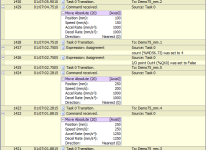I consider the ability to do maximum programming with keyboard only, without mouse, essential for any PLC development environment although the "command-line only" approach also seems like an overkill. After all the ability to do online editing with as little keystrokes as it is reasonably possible is probably even more important and this is certainly not an option with the way the OP suggests: edititng the program in a text editor, then updating via command line.
A good IDE must, IMO, include well-thought set of key combinations for virtually every operation and command in the set. If it is ST or other text-based program, there must be an easy way to type in any variable declaration statement without having to switch to a different screen area or a separate tab with mouse, and to have drop-down prompts as one begins to type the name of the existing variable... correcting the case in the process! Case-sensitive variable names may work in C, but they are just nuisance in the PLC world. If it is LD or other graphics-based program, there must be keystrokes for any kind of contacts and coils, one-shots, timers, parallel branches and any 'box-style' operator, function or command.
A good hands-on test is: how easy is it to debug and correct your program while having to hold your laptop in the palm of one hand and entering the code with another hand while standing next to a working machine in a hot, dusty and noisy production area? This is probably an extreme for the most of the controls people but it does happen and this is something many PLC software developers do not seem to consider well.
20+ years ago I used to work a lot with GE Logicmaster 90 (still DOS-based) and I was able to quickly type in the whole ladder code with just the keyboard. I have not work that much with AB and Omron devices but I know the same can be accomplished there - or at least used to be. These days I work mostly with Yaskawa MotionWorks (non-IDE version) and I can do exactly the same: type the whole ladder in barely having to touch mouse.






